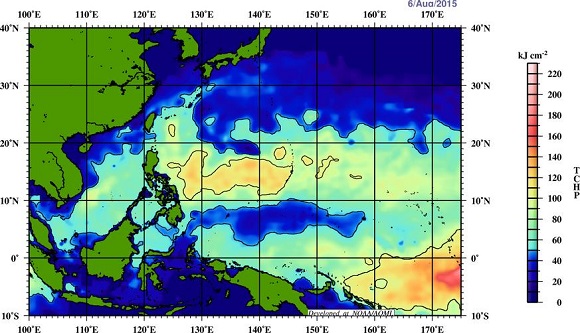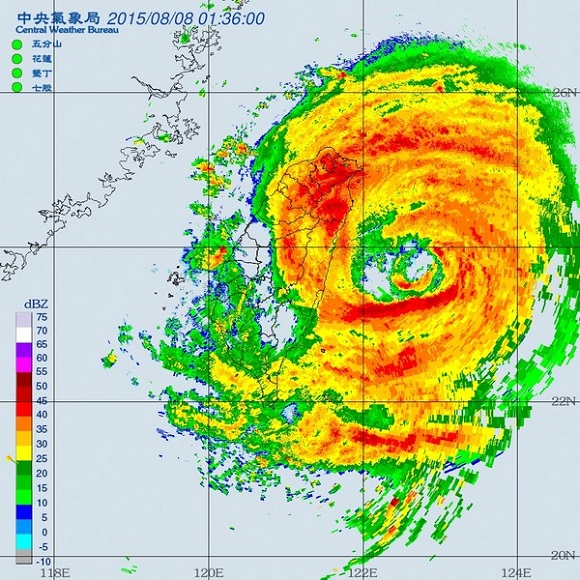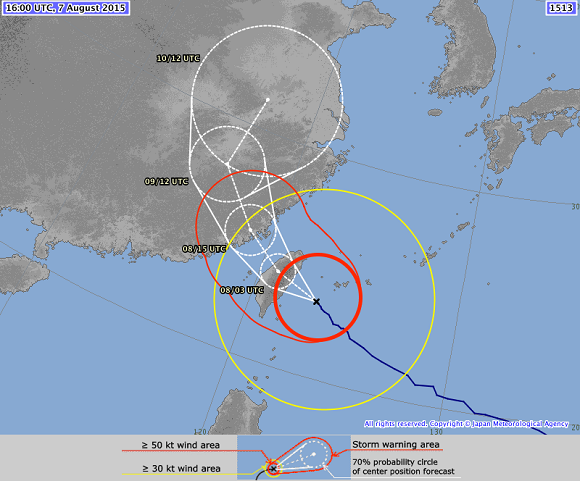Typhoon Soudelor 2015
Status: Closed
| Type of posting | Posting date(EST): | Summary | Downloads |
|---|---|---|---|
| Landfall | 8/10/2015 1:00:00 PM |
|
|
| Pre-Landfall 2 | 8/7/2015 1:15:00 PM |
|
|
| Pre-Landfall 1 | 8/5/2015 11:45:00 AM |
|
Pre-Landfall 2 | Summary
Posting Date: August 7, 2015, 1:15:00 PM
After causing significant damage across Saipan earlier this week, Typhoon Soudelor is approaching a second landfall in Taiwan. As of 16:00 UTC, August 7, 2015, Typhoon Soudelor was located at 23.3°N, 123.1°E, according to the Japan Meteorological Agency (JMA). Soudelor is tracking to the west-northwest at around 20 km/h and is poised to make landfall along the central east coast of Taiwan around 00:00 UTC on August 8. Soudelor is a strong typhoon with the JMA estimating a minimum central pressure of 935 mb and maximum 10-minute sustained wind speed of 167 km/h (183 km/h 1-minute sustained) as of 16:00 UTC, August 7. Infrared satellite imagery reveals a fairly well-organized structure with a void in convection on the western side wrapping in towards the center (Figure 1), likely due to the entrainment of relatively drier air from the environment.
.gif)
Meteorological Summary and Forecast
Soudelor has been unable to re-attain its lifetime peak intensity, which was achieved on August 4, when the JMA estimated the typhoon’s minimum central pressure as 900 mb and maximum 10-minute sustained wind speeds of 212 km/h (233 km/h 1-minute sustained). Since that time, Soudelor has passed over a patch of ocean with relatively low oceanic heat content (OHC) as indicated by the red oval in Figure 2. OHC is a measure of the total integrated heat energy in the upper ocean, and it is a more comprehensive metric than sea surface temperature (SST) for gauging the energy available to a tropical cyclone. Atmospheric and oceanic conditions appear favorable for some intensification prior to landfall in Taiwan, as wind shear remains low and Soudelor recently passed over a warm ocean eddy with locally high OHC. Nonetheless, Soudelor is a large tropical cyclone, which tends to reduce the likelihood for rapid intensification, and possible entrainment of dry air into the storm core on the western side may also inhibit re-intensification. The JMA forecast indicates that Soudelor will maintain its present intensity through landfall, after which rapid weakening will commence.



Exposure at Risk
While not directly in Soudelor’s anticipated track, the northeast of the country, where the capital Taipei is located, is likely to be most affected because of the relatively high concentration of exposures there. Any deviation of the storm from its forecast track to the north will result in more serious impacts for Taipei, while deviation to the south would tend to lessen the impact to exposures in Taiwan.
At the estimated wind speeds of Typhoon Soudelor, Taiwan’s building stock is expected to fare reasonably well, with limited instances of significant structural damage. Storm surge may affect coastal communities while inland flooding is expected to cause significant damage to some low-rise structures, and minor roof and wall cladding damage from wind is likely. However, landslides could cause considerable damage, as they did in 2009 when Typhoon Morakot’s extreme rainfalls caused landslides that devastated the village of Xiaolin. Nearly 450 people were killed, buildings were destroyed, roads were buried, and other infrastructure, such as bridges, were compromised.
The low- to mid-rise buildings of Taiwan typically have reinforced concrete frames with brick infill walls. Some masonry residential buildings can also be found, although these are usually built prior to 1950. In recent years, these residences have given way to mid-rise apartment buildings and three-story street houses, with both types generally of masonry construction. Most of the buildings in Taiwan are fairly new, however, and recent residences tend to be high-rise complexes built in clusters. These are predominantly reinforced concrete, many with ceramic façades, although some are steel.
Taiwan’s residential buildings usually have commercial establishments on the ground floor, while the upper stories are used for residential purposes. The mixed occupancy use in Taiwan makes the vulnerability of residential and commercial lines of business very similar.
The commercial and industrial buildings in Taiwan usually only date back to 1970 or later because before that time the country relied more heavily on agriculture. These buildings are therefore generally built to better structural standards. About half of Taiwan’s commercial and industrial stock is made of steel while the rest is mostly reinforced concrete.